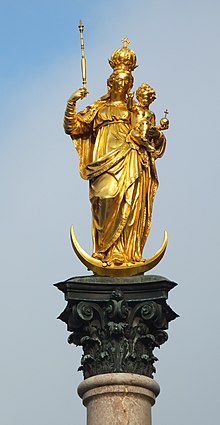Marian and Holy Trinity columns

Marian columns are religious monuments depicting
History

In Imperial Rome, it was the practice to erect a statue of the Emperor atop a column. In 1381, Michael Tutz erected the gothic Tutzsäule at Klosterneuburg Monastery to mark the ending of an epidemic.[citation needed]
The Christian practice of erecting a column topped with a statue of the Virgin Mary became common especially in the Counter-Reformation period following the Council of Trent (1545–1563).[citation needed]
The column in
Dreifaltigkeitssäule

The basic model which inspired building most Holy Trinity columns is that in the
There is a Holy Trinity Column in Holy Trinity Square, in front of Matthias Church in Budapest, a plague memorial erected in 1713, which served as a model for many similar works in the country.[5]
The era of these religious structures culminated with the outstanding
There is also a Holy Trinity Column in the main square of Linz. The Holy Trinity Column in Teplice was designed by Matthias Braun and erected in thanksgiving for the city having been spared the plague in 1713. Braun also designed the Marian column in Jaroměř.[citation needed]
-
Holy Trinity Column, Matthias church, Budapest
-
Holy Trinity Column Linz, Austria
-
Dreifaltigkeitssäule, Zwettl
-
Dreifaltigkeitssäule, Sopron
Mariensäule

The first column of this type north of the
The
The Column of the Virgin Mary Immaculate in Kutná Hora was constructed by the Jesuit sculptor František Baugut between 1713 and 1715 to commemorate the recent plague.[8]
The Marian column in Český Krumlov's town square was completed in 1716. At the base are statues of SS. Sebastian, Wencelaus and Vitus. It commemorates the plague of 1697. In gratitude for the end of the plague in 1680 at Maribor, a plague column was built in 1681, with the original being replaced in 1743. Arranged around a pillar bearing an image of Virgin Mary, are six saints, all intercessors against the plague.[9]
-
Marián column Prague
-
Marian column Cesky Krumlov town square
Pestsäule

Over time distinctions between a Marian column and a plague column blurred. Although plague columns are most commonly dedicated to the Virgin Mary, some depict other saints. [citation needed]
The Plague Column at Eisenstadt was erected in 1713 in honour of the Holy Trinity and by Mary, as Queen of heaven as a plea to God to free the city from the plague. On the pedestal there are represented Saints Roch, Sebastian, Kajetan, John of Nepomuk, Saint Rosalie, and Saint Francis.[10]
The Guglia di San Domenico designed by Cosimo Fanzago, was erected after the plague of 1656.[11]
-
King Charles IV of Hungary, taking his Coronation Oath on 30 December 1916 at Holy Trinity Column in Budapest
-
Obelisco di san Domenico (Napoli)
-
Plague Column, Kremnica
See also
References
- ^ Tiessen-Wiens, Brenda. "A column about plague columns", Canadian Mennonite Magazine, May 20, 2020
- ^ Il Divoto Pellegrino Guidato, ed Istruito nella Visita delle quattro Basiliche di Roma, per il Giubileo dell'Anno Santo 1750., Stamperia del Characas, presso San Marco al Corso, Rome, 1749, page 338-339.
- ^ Meier, Allison C., "How to Memorialize a Plague", Jstor Daily, May 1, 2020
- ^ Pleschberger, Johannes. "Worried Vienna residents flock to Plague Column to ask for protection", Euronews, March 31, 2020
- ^ "18th century. 1713 The Holy Trinity Statue". Matthias Church Official website.
- ^ "Olomouc (Czech Republic)" (PDF). Ehc.unesco.org. Retrieved 2016-06-24.
- ^ Paces, Cynthia. "The Fall and Rise of Prague's Marian Column", Radical History Review 79 (2001) 141-155
- ^ "Sloup se sousoším – Morový sloup". Prague: National Heritage Institute.
- ^ "Plague Column", Maribor Tourist Board
- ^ "Plague Column", Burgenland Neusiedler See
- ISBN 9780571249015.
- ^ Knight, Christopher. "U.S. should build a memorial ‘plague column’ for COVID-19, but where?", Los Angeles Times, May 5, 2020









